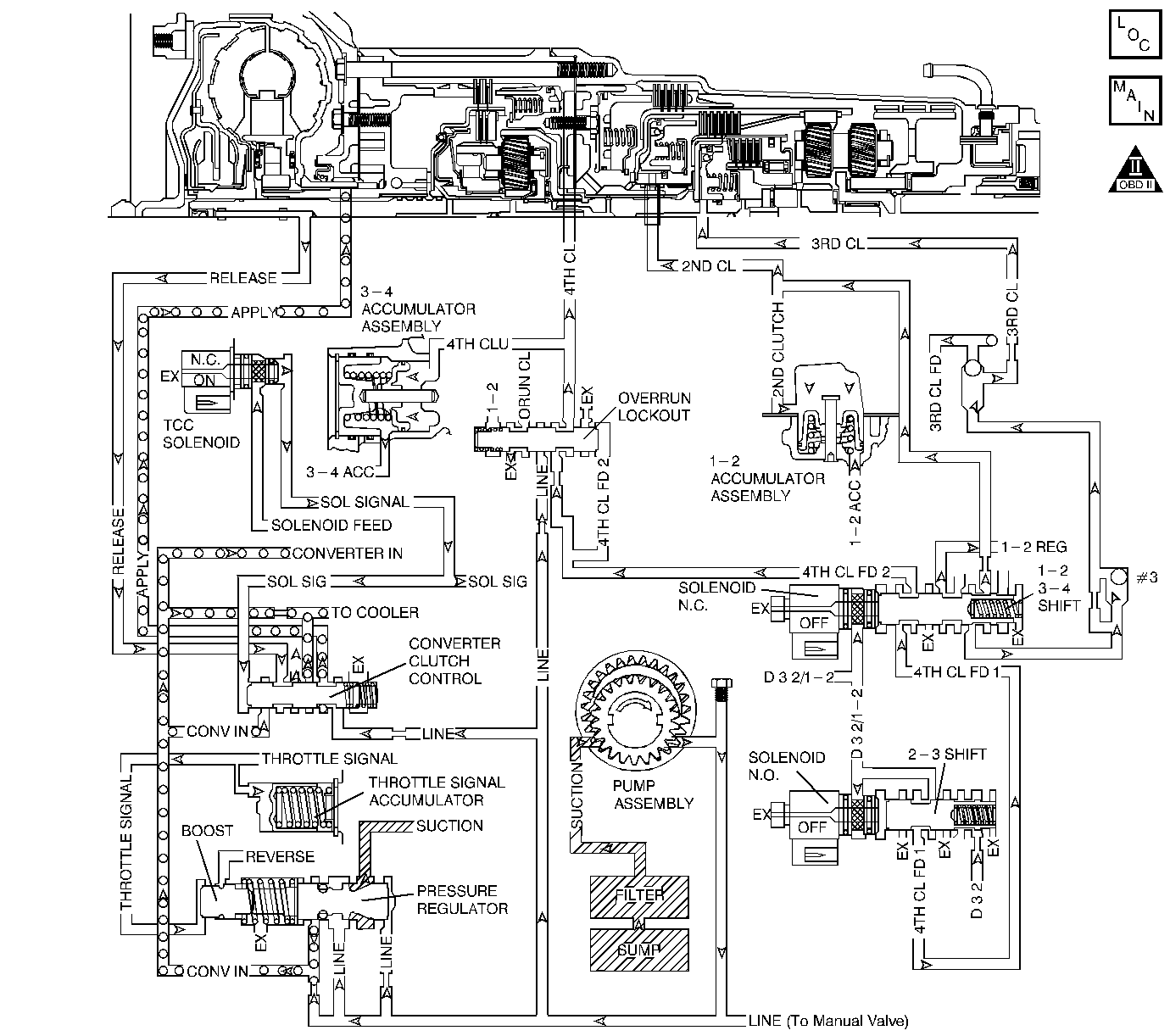
Circuit Description
The transmission control module (TCM) monitors the engine speed, the transmission output speed and the current gear. The TCM calculates turbine shaft speed and torque converter clutch (TCC) slip speed by using these inputs. When the TCM commands third gear with the TCC engaged, the engine speed should be approximately the same as the transmission output speed. When the TCM commands fourth gear with the TCC engaged, the TCC slip speed should be -20 to +64 RPM. Refer to the Range Reference table for solenoid states and transmission components that are active in third or fourth gear with the TCC commanded ON.
When the TCM detects excessive TCC slip when the TCC should be engaged, then DTC P1870 sets. DTC P1870 is a type B DTC.
Conditions for Running the DTC
| • | The transmission is not in P, R, or N. |
| • | The transmission is not in default mode. |
| • | The TCC is commanded on. |
| • | No incorrect gear ratio DTC P0730. |
| • | The following code enabling and fail conditions are not met: |
| - | P0751 conditions 1 and 2 |
| - | P0752 conditions 1 and 2 |
| - | P0757 conditions 1 and 2 |
Condition for Setting the DTC
The TCM calculated transmission slip is greater than 288 RPM for 3.825 seconds.
Action Taken When the DTC Sets
| • | The TCM flashes the sport mode lamp and sends a MIL request to the ECM on the second consecutive drive trip that the diagnostic runs and fails. The ECM then illuminates the MIL. |
| • | The ECM records the operating conditions in the Freeze Frame at the time of the MIL request from the TCM. |
| • | The transmission operates in the default mode (maximum line pressure, command 4th gear, inhibit TCC, freeze shift adapts). |
Conditions For Clearing the MIL/DTC
| • | The ECM turns off the MIL after three consecutive drive trips during which the TCM sends no MIL request. |
| • | A History DTC clears after forty consecutive warm-up cycles, if no failures are present by this diagnostic or any other emission related diagnostic. |
| • | The scan tool clears the MIL/DTC. |
| • | The TCM cancels the DTC default mode actions when the ignition switch is Off long enough in order to power down the TCM. |
Diagnostic Aids
| • | A transmission tends to slip more when it is hot. Duplicate the engine and transmission temperatures from the Failure Records before attempting to duplicate DTC P1870. |
| • | Verify that the customer is not overloading the vehicle, towing beyond vehicle capacity, or towing in Overdrive (D4). |
Test Description
The number below refers to the step number on the diagnostic table.
Step | Action | Value(s) | Yes | No | ||||||||||||||||||
|---|---|---|---|---|---|---|---|---|---|---|---|---|---|---|---|---|---|---|---|---|---|---|
1 | Did you perform Powertrain On Board Diagnostic (OBD) System Check - Automatic Transmission ? | -- | Go to Powertrain On Board Diagnostic (OBD) System Check - Automatic Transmission | |||||||||||||||||||
2 | Perform the Transmission Fluid Check . Is the action complete? | -- | -- | |||||||||||||||||||
Important: Record the Failure Records before clearing the DTCs. Using the Clear Info function erases the Failure Records from the ECM and the TCM. Is the Scan Tool TCC Slip Speed greater than the specified range? | 288 RPM | Go to Diagnostic Aids | ||||||||||||||||||||
4 | Inspect the torque converter clutch solenoid valve for the following conditions:
Did you find a condition? | -- | ||||||||||||||||||||
5 |
Did you find a condition? | -- | ||||||||||||||||||||
6 | Inspect the torque converter assembly for the following conditions:
Did you find a condition? | -- | ||||||||||||||||||||
7 | Inspect the oil pump assembly for the following conditions:
Refer to Transmission Overhaul in the 4L30-E Section of the Transmission Unit Repair. Did you find a condition? | -- | ||||||||||||||||||||
8 | Inspect the turbine shaft for the following conditions:
Refer to Transmission Overhaul in the 4L30-E Section of the Transmission Unit Repair. Did you find a condition? | -- | ||||||||||||||||||||
9 | Inspect the 4th clutch assembly for the following conditions:
Refer to Transmission Overhaul in the 4L30-E Section of the Transmission Unit Repair. Did you find a condition? | -- | ||||||||||||||||||||
10 | Inspect the 3rd clutch assembly for the following conditions:
Refer to Transmission Overhaul in the 4L30-E Section of the Transmission Unit Repair. Did you find a condition? | -- | ||||||||||||||||||||
11 | Inspect the 2nd clutch assembly for the following conditions:
Refer to Transmission Overhaul in the 4L30-E Section of the Transmission Unit Repair. Did you find a condition? | -- | Go to Diagnostic Aids | |||||||||||||||||||
12 | Perform the following procedure in order to verify the repair:
Is the Scan Tool TCC Slip Speed less than the specified value? | 288 RPM | System OK |
